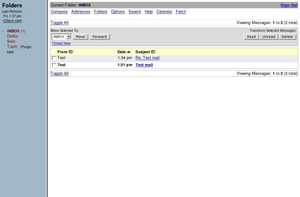SquirrelMail
 | |
|
Screenshot of the SquirrelMail message view | |
| Original author(s) | Nathan and Luke Ehresman[1] |
|---|---|
| Developer(s) | The SquirrelMail Project Team |
| Initial release | 14 December 1999[2] |
| Stable release | 1.4.22 (12 July 2011) [±] |
| Preview release |
1.5.2
/ 17 August 2012 |
| Development status | Active |
| Written in | PHP, C |
| Operating system | Linux, OS X, Windows, etc. |
| Platform | Web platform |
| Available in | More than 50 languages[3] |
| Type | Webmail |
| License | GNU General Public License v2 |
| Website |
www |
SquirrelMail is a project that provides both a web-based email client and a proxy server for the IMAP protocol.
History
The webmail portion of the project was started by Nathan and Luke Ehresman[1] in 1999 and is written in PHP. SquirrelMail can be employed in conjunction with a LAMP "stack", and any other operating systems that support PHP are supported as well. The web server needs access to the IMAP server hosting the email and to an SMTP server to be able to send mails.[4]
SquirrelMail webmail outputs valid HTML 4.0 for its presentation, making it compatible with a majority of current web browsers. SquirrelMail webmail uses a plugin architecture to accommodate additional features around the core application, and over 200 plugins are available on the SquirrelMail website.[5]
The SquirrelMail IMAP proxy server product was created in 2002 by Dave McMurtrie while at the University of Pittsburgh (where it was named "up-imapproxy", although it has become more commonly known as "imapproxy") and adopted by the SquirrelMail team in 2010.[6] It is written in C and is primarily made to provide stateful connections for stateless webmail client software to an IMAP server, thus avoiding new IMAP logins for every client action and in some cases significantly improving webmail performance.
Both SquirrelMail products are free and open-source software subject to the terms of the GNU General Public License (GPL) version 2.
SquirrelMail webmail is included in the repositories of many major GNU/Linux distributions[7][8][9][10][11][12][13][14][15] and is independently downloaded by tens of thousands of people every month.[16]
Platforms
SquirrelMail webmail is available for any platform supporting PHP. Most commonly used platforms include Linux, FreeBSD, OS X and the server variants of Microsoft Windows. SquirrelMail IMAP Proxy compiles on most flavors of Unix, and can generally be used on the same platforms as the webmail product can be with the exception of Microsoft Windows, unless used in a Cygwin or similar environment. Apple shipped SquirrelMail as their supported web mail solution in Mac OS X Server.[17]
Plugins
The SquirrelMail webmail client itself is a complete webmail system, but extra features are available in the form of plugins. There are over 200 third-party plugins available for download from the SquirrelMail website and SquirrelMail ships with several "standard" or "core" plugins.
Internationalization
SquirrelMail webmail has been translated into over 50 languages including Arabic, Chinese, French, German, and Spanish.[3]
Notable installations
SquirrelMail has been implemented as the official email system of the Prime Minister's Office of the Republic of India for its security advantages over Microsoft's Outlook Express.[18][19][20][21]
HEC Montréal deployed SquirrelMail as part of a comprehensive webmail solution, to support thousands of users.[22]
See also
References
- 1 2 "SquirrelMail history". Squirrelmail.org. Retrieved 2009-08-11.
- ↑ "Squirrelmail ChangeLog". Retrieved 2009-12-13.
- 1 2 "SquirrelMail translation statistics". L10n-stats.squirrelmail.org. 16 June 2009. Retrieved 2009-08-11.
- ↑ "SquirrelMail, a Web-Based Mail Server – O'Reilly Media". onlamp.com. Retrieved 2010-07-29.
- ↑ Wallen, Jack (7 August 2007). "SolutionBase: Taking SquirrelMail to new levels". Articles.techrepublic.com.com. Retrieved 2010-10-31.
- ↑ "IMAP Proxy home page". Retrieved 2010-11-15.
- ↑ "Fedora Package Database – squirrelmail". fedoraproject.org. Retrieved 2010-03-06.
- ↑ "Novell: openSUSE 10.3: squirrelmail". novell.com. Retrieved 2010-03-06.
- ↑ "Debian – Package Search Results – squirrelmail". debian.org. Retrieved 2010-03-06.
- ↑ "CentOS Package List". centos.org. Retrieved 2010-03-06.
- ↑ "CentOS SquirrelMail Package". centos.org. Retrieved 2010-03-06.
- ↑ "Ubuntu – Package Search Results – squirrelmail". ubuntu.com. Retrieved 2010-03-06.
- ↑ "Gentoo Packages /package/mail-client/squirrelmail". gentoo.org. Retrieved 2010-03-06.
- ↑ "FreeBSD Ports Search – squirrelmail". freebsd.org. Retrieved 2010-03-06.
- ↑ "Port description for mail/squirrelmail". freebsd.org. Retrieved 2010-03-06.
- ↑ "Project Statistics for SquirrelMail". sourceforge.net. Retrieved 2010-03-06.
- ↑ "Peachpit: Mac OS X Server Mail Service Boot Camp: Advanced Mailing List Features and Web Mail". 13 October 2006. Retrieved 2010-08-30.
- ↑ "Microsoft dumped after India PM's emails go AWOL". theregister.co.uk. 17 March 2009. Retrieved 2010-03-06.
- ↑ "PMO's email system infected for three months". The Times of India. 15 March 2009. Retrieved 2010-03-06.
- ↑ "Indian PM Abandons Outlook for Open-Source Email". infopackets.com. 20 March 2009. Retrieved 2010-03-06.
- ↑ "No Microsoft mail for PM". techgoss.com. 16 March 2009. Retrieved 2010-03-06.
- ↑ "HEC Montréal: Deployment of a Large-Scale Mail Installation". linuxjournal.com. 1 May 2004. Retrieved 2010-07-25.
